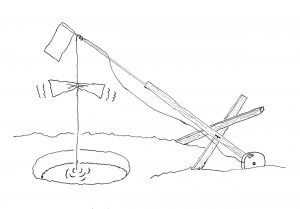Ice Fishing Tips
This article was written by Matt LaRoche and first appeared in the January edition of the Northwoods Sporting Journal.
Did you ever notice that some ice anglers seem to be luckier than others? I think you will find that these “lucky” fishermen have one thing in common – they are always fiddling with their bait, changing the depth of whatever they are fishing with or trying something new. It is a habit that is almost the polar opposite of what a good hunter does – which is sit still.
How often have you neglected tending your tip ups only to find when you finally did go around to check them that the bait was gone or you had a fish on the line that didn’t set the flag off? That would tell me that you should have been checking your traps more often.
Sometimes the fish are not cooperating despite the fact that we have been checking our traps regularly, trying different depths and keeping the holes free of ice. This is when we need to bring out the proverbial bag of tricks.
One of the most important things you can do is move a few traps to see if that makes a difference and try fishing at different levels under the ice. One tactic I have tried successfully over the last few years is fishing in deep water with bait six feet under the ice. I have caught some nice brook trout and togue using this method.
If you really want to try something different, especially when the lake you are fishing prohibits the use of live fish as bait – try this: Take your tip up out of the water and stick the cross pieces that hold the trap over the hole into the snow next to the hole, then take the line and run it from the reel over the upright part of the trap, then wrap the line once around the end of the fully extended spring and down the whole. The next part is the most important step in the directions, tie a piece of news paper in the line between the hole and the end of the spring. When the wind blows the paper it will move the line – giving the bait movement and making it look quite lively. On a really cold day this method will not work well because the line will freeze in the hole and not move as it should.
Another method that will often times work when the fish are not biting well is to jig. Take a short fishing rod, stick or even an unused trap and tie a heavy lure on the end of the line and move it up and down. You can try jigging with a piece of cut bait on the hook or not – I have had luck both ways. I usually start jigging just off the bottom, close enough to the bottom so you are stirring up a little silt or mud with the action of the lure on the down stroke. I then work my way up in ten-foot increments until I’m fishing right under the ice. Togue and whitefish like to inhabit the bottom of our lakes, so I recommend concentrating your jigging efforts in that area.

If you haven’t caught anything after jigging in a spot for an hour or so, drill a new hole a hundred feet away and start the process all over again. If you’re persistent you will eventually be rewarded. There is a bit of a knack to jigging. When you get the lure working just right, it will make a circle under the ice. This skill is like anything else, the more you do it the better you will become.
The headwater lakes of the Allagash Wilderness Waterway (AWW) are a great place to ice fish. There are plenty of native brook trout, togue and whitefish waiting to accommodate those hardy enough to venture out on its frozen waters. Most winters, the biggest brook trout are caught during the first few weeks of the season.
Please go to www.maine.gov/allagash or check in at the Chamberlain Bridge ranger station for current ice conditions on the AWW headwater lakes.
Matt LaRoche is a retired Superintendent of the Allagash Wilderness Waterway, owner of Maine Woods Guide Service and an avid outdoorsman. He can be reached at 207-695-2877 or at matt.laroche2877@gmail.com . See www.mainewoodsguide.com
